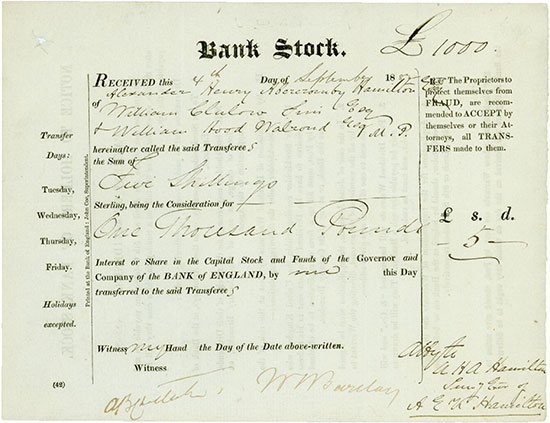Ingelsberg 17 b
D- 85604 Zorneding
Deutschland / Germany
Tel.: +49 (0)8106 - 2461-86
Fax: +49 (0)8106 - 2461-88
E-Mail: auktion@hwph.de
HWPH Historisches Wertpapierhaus AG –
Az ön muzeális értékpapírok és
gazdaságtörténelem szakkereskedője
|
||||
Megnevezés |
1094 | |||
Tétel |
Bank of England | |||
Helyszín(ek) |
||||
Ország |
Großbritannien | |||
Régió |
Europa | |||
Leírás |
04.09.1882, Bank Stock über £ 1.000, o. Nr., 16,7 x 21,5 cm, schwarz, grau, Knickfalten, links oben Loch, in außergewöhnlich guter Erhaltung, üblicherweise ist die linke obere Ecke abgerissen. | |||
Leírás (Angol) |
4 September 1882, Bank Stock for £ 1.000, o. Nr., 16.7 x 21.5 cm, black, grey, folds, hole at upper left edge, unusually top condition, these usually have a torn corner at top left. | |||
Jelenleg tartott licit |
EF | |||
 |
||||
Történet (Németül) |
Der Kerngedanke der britischen finanziellen Revolution war, die öffentlichen Schulden vollständig von dem (persönlichen) Kredit einer Person, nämlich des sich stets in Geldnöten befindlichen regierenden Monarchen, zu trennen – mit dem Ziel, die tatsächlich in der gesamten Volkswirtschaft vorhandenen finanziellen Ressourcen zu mobilisieren. In diesem Zusammenhang wurde durch einen Parlamentsakt eine Gruppe reicher Londoner Geschäftsleute autorisiert, 1694 eine besonders privilegierte Organisation, die Bank of England, zu errichten. Die Bank of England kaufte dem Staat im Gegenzug für die erhaltenen Privilegien in Höhe ihres gesamten Aktienkapitals von 1,2 Millionen Pfund Staatsschulden ab, die in zinstragenden sog. „Annuities“ verbrieft wurden. Mit der Erfindung des sog. „sinking fund“, einem aus bestimmten Steuern gespeisten Reservefonds zur (angeblichen) späteren Tilgung der Annuities, konnte das System glaubwürdig gestaltet werden. Gleichzeitig begann die Bank of England, Annuities regelmäßig an der Londoner Börse zu kaufen und zu verkaufen und so für einen permanent funktionsfähigen Markt zu sorgen. Das wichtigste Ergebnis dieser Maßnahmen war, dass die Öffentlichkeit, d. h. die maßgeblichen englischen Geschäftsleute, nach und nach überzeugt wurden, dass die verzinslichen Staatsanleihen jederzeit auch wieder zu Bargeld (Gold- und Silbergeld) gemacht werden konnten. Im Unterschied dazu waren Europas Monarchen wegen ihrer mangelhaften Zahlungsmoral mehr als berüchtigt. Die Kaufleute begannen deshalb, die von königlicher Willkür losgelösten Staatsanleihen auch als Sicherheit für Privatkredite zu akzeptieren. Der Bank of England wiederum wurde es dadurch möglich, Notes (heute: Banknoten) zu emittieren, die bald, genauso wie Gold, als allgemeines Tauschmittel angenommen wurden, ohne dass dies eigentlich systematisch vorausgeplant worden war. Als Sicherheit dienten nicht mehr lediglich Goldreserven, sondern auch die Annuities im Portefeuille der Bank of England. Dadurch, dass sich Annuities und Banknoten in ihrer Funktion wechselseitig unterstützten, wurde letztlich die englische Staatsschuld zum Nutzen der expandierenden Gesamtwirtschaft „monetisiert“. Vor diesem Hintergrund erschien es dann keineswegs mehr empfehlenswert, die Staatsschuld tatsächlich zurückzuzahlen, was nämlich nur die Geldversorgung und das mögliche Kreditvolumen zur Finanzierung der Umsatzprozesse in der Volkswirtschaft reduzieren, die Wirtschaftsentwicklung somit hemmen und folglich den Wohlstand der Volkswirtschaft mindern würde. Quelle: Prof. Dr. Udo Hielscher, DIE FLORENTINISCHEN MONTI. | |||
Történet (Angol) |
The central idea of the British Financial Revolution was the complete separation of the public debt from the (personal) credit of a person, namely the ruling monarch who had always shortage of money. The goal of this step was to mobilise the total financial resources of the whole economy. Therefore a group of rich London businessmen were authorised by an act of parliament to establish an organisation with special privileges, the Bank of England. In compensation for the give privileges the Bank of England bought from the government their liabilities. The amount of the liabilities was 1.2 million pounds, correlated with the share capital of the Bank of England and was securitised in interest bearing Annuities. The system got its credibility by the invention on the sinking fund. This fund was a reserve fund fed by particular taxes and should be used to repay the annuities. The Bank of England started to buy and sell annuities at the London Stock Exchange at the same time. That created a permanent existing, workable market. The most important result of this step was, that the public – especially the essential British businessmen – were convinced step-by-step, that the interest bearing government bonds could be exchanged into cash (gold and silver coins) at any time. In opposite to this system the other European monarchs were well known for their bad payment practices. Because of the solidity of the British system the merchants started to accept the government bonds as security for private lending. The Bank of England came into the possession to issue notes (today banknotes) which were accepted as means of exchange in the same was as gold after a short period of time. This happened although it was not strategically planned by the Bank of England. Not only the gold deposits, but also the annuities in the treasure of the Bank of England were accepted as security. Banknotes and Annuities supported each other in their function. The English government debt was monetised for the benefit of a growing economy. Against this background it was not lucrative to pay back the government debt, because this would reduce the money supply and the potential credit volume available for turnover in the economy. Furthermore this would mean a reduction in prosperity. Source: Prof. Dr. Udo Hielscher, DIE FLORENTINISCHEN MONTI. | |||
Vegye figyelembe aukciónk top-darabjait is: |
||||













